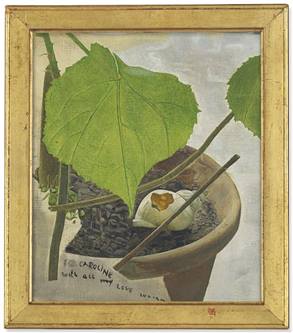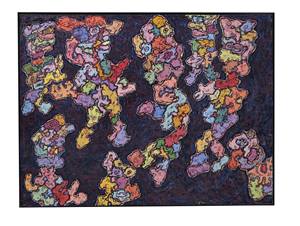It may take several months for an artwork to leave the consignor and reach the packed salesroom at Christie’s King Street. Once the work arrives at Christie’s warehouse, the exciting detective work starts. Specialists need to inspect the condition, explore provenance, and create cataloguing that presents the story of each unique object in an accessible and clear way.
“Often the inscriptions and labels on the reverse of a canvas offer a useful indication of the provenance of a work. It points us in the right direction to continue the search through specific museum exhibition catalogues or gallery publications,” says Bojana Popovic, Junior Specialist in Christie’s Post-War and Contemporary Art department, and frequent Christie’s Education lecturer.
Can you share an interesting story on the journey of an artwork to Christie’s?
Last October we had a beautiful little gem of a painting by Lucian Freud in our Evening Auction titled Still Life with Zimmerlinde (circa 1950). Painted while the artist was in his twenties and inscribed ‘For Caroline with all my love Lucian’ the small cut piece of canvas depicted a heart-shaped leaf arising from a house lime in a simple clay pot. Never before seen in public, this intimate study by Freud, dedicated to the artist’s second wife, Caroline Blackwood, has the silken clarity of the artist’s early painting. One can only imagine that this little delicately painted still life was a tender gift during the early years of what would become a tumultuous relationship. It was later acquired from Lady Caroline by the grandmother of the owner who came to sell it through Christie’s. Thus, it had been in the same collection for over 70 years and a real treasure to behold.

Lucian Freud (1922-2011), Still Life with Zimmerlinde, oil on canvas, 9 7/8 x 8 ½in. (25 x 21.5cm.), ESTIMATE £400,000 - £600,000, Price Realised £908,750
What do you do with an artwork once it arrives at Christie’s?
As soon as a work arrives with us we view the piece in the warehouse to inspect the condition and take cataloguing notes, such as measurements, medium and so on. Often the inscriptions and labels on the reverse of a canvas offer a useful indication of the provenance of a work. It points us in the right direction to continue the search through specific museum exhibition catalogues or gallery publications. After ensuring that the work is in good condition, our professional in-house photographers shoot the work in its entirety as well as for textured details that we can later use in our catalogues.
What happens next?
Once the work has been researched, we compile a list of queries. Are there missing steps in the provenance? Could the work have been exhibited at a show where there was no catalogue? It is then that we reach out to the artist foundations, studios or the representing gallery for each artist, an excellent way for us to ensure that our cataloguing is correct, precise and that no stone has been left unturned. Through archive installation images and studio shots showing the work in process, and through our essays and illustrations, we try to convey the historic importance of the work as well as the position of the artist within the Post-War and Contemporary art category. If a work was exhibited at a major museum retrospective for example, this would certainly add to its historic value and contextualise the piece within the artist’s oeuvre.

Is this what Christie’s Education students learn during the tour through Christie’s warehouse with you?
As with any type of learning I think getting hands-on experience is the best way to see exactly what working in an auction house entails and more specifically, the process of cataloguing, valuing and condition checking. Even a few hours in the warehouse with a specialist can offer an excellent insight into what we do here at Christie’s. I enjoy taking groups of students from Christie’s Education to the warehouse because it allows them to assess paintings, drawings or sculptures for themselves – I usually like to give them some time with a work of art and ask them what they would note down or question before going into a bigger discussion. With our area of expertise, so much is learnt from looking and training the eye to notice certain details.
What do you like the most about working as a specialist at Christie’s?
It has given me a unique opportunity to see a broad range of quality artworks first-hand. There is something truly awe-inspiring about seeing a masterpiece for the first time in our warehouse after it has been hidden away for decades in a private collection. With every auction, you have the chance to discover new artists or see first-hand works of art from a chapter of an artist’s life that you might be less familiar with. For example, our upcoming Post-War and Contemporary Art Evening Auction on 25 June will be the first time we are offering a work by Tschabalala Self, who is a very promising young American artist. Apart from her, we will present thirty-five top-quality works, with a balanced focus on up-and-coming Contemporary artists as well as Post-War masters, including Leon Kossoff, Frank Auerbach, Gerald Laing and Derek Boshier. Meanwhile, we also have a strong grouping by American Pop artists including Andy Warhol and Jean-Michel Basquiat.
What is your top pick from the upcoming Post-War and Contemporary Art sale?
Jean Dubuffet’s Cérémonie, painted in 1961 from the pinnacle of the artist’s career, is one of my personal favourites. This work has been held in the same private collection for thirty years and it represents one of the largest works from Dubuffet’s celebrated Paris Circus series, which is considered one of the most important artistic achievements of the post-war period. There are only nine other paintings over two metres in size in the Paris Circus series, of which three are in museums, so it is rare to see a canvas like this one up at auction.

Jean Dubuffet (1901-1985), Cérémonie (Ceremony), Estimate GBP 7,000,000 - GBP 10,000,000 to be offered at Post-War and Contemporary Art Evening Auction on 25 June 2019 in London
*The banner and thumbnail image: Jean-Michel Basquiat (1960-1988), Sabado por la Noche (Saturday Night), Estimate GBP 7,500,000 - GBP 11,000,000 to be offered at Post-War and Contemporary Art Evening Auction on 25 June 2019 in London

